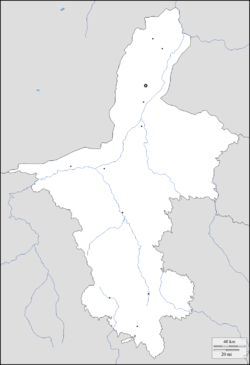Haibao Pagoda Temple
The Haibao Pagoda Temple (simplified Chinese: 海宝塔寺; traditional Chinese: 海寶塔寺; pinyin: Hǎibǎotǎ Sì) is a Buddhist temple located in Xingqing District of Yinchuan, Ningxia, China. Because of earthquakes, the modern temple was founded in the 18th century in the period of the Qianlong Emperor (1736–1796) during the mid-Qing dynasty (1644–1911). It is the headquarters of the Buddhist Association of Ningxia.[2]
| Haibao Pagoda Temple | |
|---|---|
海宝塔寺 | |
 Haibao Pagoda | |
| Religion | |
| Affiliation | Buddhism |
| Deity | Linji school |
| Leadership | Guozhen (果真法师)[1] |
| Location | |
| Location | Xingqing District, Yinchuan, Ningxia |
| Country | China |
 Shown within Ningxia  Haibao Pagoda Temple (China) | |
| Geographic coordinates | 38°29′53″N 106°17′14″E |
| Architecture | |
| Style | Chinese architecture |
| Date established | 5th century |
| Completed | 18th century (reconstruction) |
History
The temple was first constructed in the early 5th century, during the Northern and Southern dynasties (420–581).[3] The temple is named after the Haibao Pagoda (海宝塔), also known as "Hebao Pagoda" (赫宝塔) and "Heibao Pagoda" (黑宝塔). According to the local county annals, the pagoda was restored by Helian Bobo (381–425), the Emperor Wulie of Xia Kingdom (407–431).[4]
The temple has been subjected to two earthquakes in 1712 and 1778, during the mid-Qing dynasty (618–907).[5]
In the early Republic period (1912–1949), it was called "Haibao Chan Temple" (海宝禅院).
In March 1961, it is listed among the "Major National Historical and Cultural Sites in Ningxia" by the State Council of China.
In October 1963, the then Vice-President Dong Biwu visited the temple. In the 1960s, Deng Xiaoping visited the temple.[6]
In 1983, the temple was categorized as a National Key Buddhist Temple in Han Chinese Area by the State Council of China.
Architecture
The entire complex faces the west and has an exquisite layout in the order of the Hall of Shanmen, Hall of Four Heavenly Kings, Mahavira Hall, Hall of Skanda and Hall of Jade Buddha.
Hall of Shanmen
The Hall of Shanmen is a gable and hip roof building. Under the eaves is a plaque with the Chinese characters "海寶塔寺" written by Zhao Puchu, the then Venerable Master of the Buddhist Association of China.[6]
Mahavira Hall
The Mahavira Hall in the main hall in the temple which placed the statues of the Three-Life Buddha. The statues of Eighteen Arhats are enshrined in the left and right side of the hall.[6]
Hall of Jade Buddha
The Hall of Jade Buddha is the hall to enshrine the statue of Shakyamuni, which was introduced from Myanmar. The 1.5-metre (4 ft 11 in) statue is made of jade.
Haibao Pagoda
The elven story, 53.9-metre (177 ft) tall, dodecagon-based Haibao Pagoda (海宝塔) is made of brick and stone, also known as the Northern Pagoda (北塔). It is built on a square brick base, each side measuring 19.7-metre (65 ft) meters long and 5.7-metre (19 ft) meters high. It is composed of a pagoda base, a dense-eave body and a thatsa.[2][7][8]
References
- 追思—银川海宝塔寺隆重举行清净长老圆寂十周年纪念追思法会. fjnet.com (in Chinese). 2016-03-18.
- "Haibo Pagoda". cri. 2005-11-03. Retrieved 16 April 2018.
- 专家考证:银川市海宝塔始建于北朝晚期至隋唐年间. Tencent (in Chinese). 2006-12-05.
- Hu Yubing (2015). 《乾隆宁夏府志》 [Prefecture Topography of Ningxia] (in Chinese). Beijing: China Social Sciences Press. ISBN 9787516157534.
- 宁夏的佛教圣地——海宝塔寺 [Ningxia's Buddhist sacred place: Temple of Haibao Pagoda]. eastday.com (in Chinese). 2016-09-23.
- 银川海宝塔(北塔) [Haibao Pagoda (Northern Pagoda) in Yinchuan]. people.com.cn (in Chinese). 2002-07-21.
- "Haibao Pagoda". china.org.cn. 2010. Retrieved 16 April 2018.
- 银川海宝塔寺 [Temple of Haibao Pagoda in Yinchuan]. fjnet.com (in Chinese). 2008-11-04.